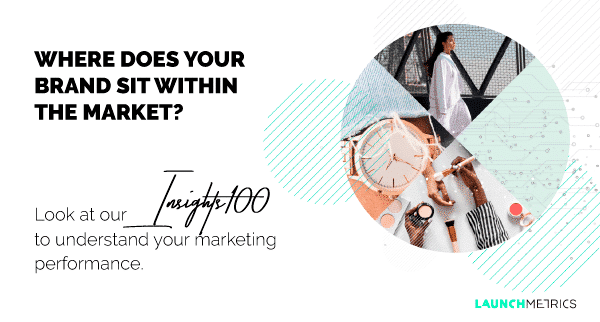According to a study by Duke University, investment in marketing analytics is expected to increase by 68% over the next three years.
A few years ago, understanding the impact and ROI of marketing activities would be largely based on guesstimations of how well campaigns were received in terms of sales or customer purchases on a general level. However, with increased growth in data resources, it is possible to provide a more accurate picture of marketing ROI, by tracking which specific Voices, channels activities and campaigns have an impact on driving customers to purchase. Resources such as Insights100 that rank brand performance by data metrics in the fashion, luxury and cosmetics industries can help brands understand their own positioning and how to potentially restrategize their brand investments for increased success.
Although existing measurement tools can give an understanding of where teams are going right (or wrong), a lot of companies are still struggling to get to grips with how to use specific metrics when measuring marketing strategies or campaigns. Our State of Influencer Marketing Report showed that brands’ biggest pain point was campaign measurement.
So, why is measurement so important when it comes to marketing investments?
Firstly, you can discover a more intimate picture of your brand value. If you had launched a specific campaign and partnered with both influencer and celebrity Voices, you could quantify the Media Impact Value™ that each individual you partnered with, brought to the brand. This would allow you to understand which Voices brought the most share of value, whether that be by engaging your audience or creating high-quality content, so that going forward you can strategize when it comes to deciding on your partnerships.
For example, mass-market cosmetics brand Morphe chose to partner with beauty influencer James Charles to create a collaboration-based product, which was also heavily promoted on the beauty guru’s Instagram and YouTube pages. James’ promotions alone brought the brand a total Media Impact Value of $45.3M in the space of three months, which helps the marketing team at Morphe visualize the sheer success of the partnership.
By getting to grips with which Influencers drive the most value in your category, in terms of MIV®, you can develop a better understanding of who to partner with on future campaigns. Whilst James Charles is the top performing influencer by MIV when it comes to mass-market cosmetics ($45.5M), the top performing influencer in the luxury cosmetics field is Sadaf Beauty ($15.6M). Understanding that influencers perform differently in different categories within your industry can also up your brand’s MIV as well as improve marketing authenticity and therefore, customer relationships.
Secondly, you can benchmark your own results against your competitors’ to find out what might work for you that could be working for them. By examining the Voice split they are activating and comparing it to your own, you might discover areas for potential brand investments that you had previously unconsidered that may be useful for your brand.
For example, the top two brands in the luxury fashion space by MIV are Gucci ($621.8M) and Chanel ($581.4M). If you take a look at the Voices they activate, their split is extremely similar – 16.6% of Gucci’s MIV is as a result of influencers, where this represents 15.7% of Chanel’s Voice share. The only noticeable difference between the two brands is that Gucci leverages their Owned Media much more than Chanel does – 17% vs. 4.8% respectively.
Companies like Chanel (or others) in the luxury fashion field could use this information to re-strategize their marketing plan, to include more emphasis on Owned Media, which could assist in increasing their overall total brand value. Benchmarking your marketing performance by the data against your competitors’ can be extremely useful when it comes to redistributing brand investments, and can prove to be an imperative tool.
Thirdly, by measuring your marketing performance, you can better build on the credibility of your brand, by making audience-based, data-driven decisions for future marketing strategies. Using these essential metrics can apply added legitimacy to the decisions you make as a brand.
Our newly launched interactive microsite, Insights100, lists a selection of brands prepared by our data analytics team to provide a comparative benchmark and offer an analytical vision of the impact that brand investments can have. The website allows visitors to discover the Media Impact Value and Voice split of brands and influencers to understand what areas brands in the fashion, luxury and cosmetics spaces invest their marketing budgets.


amy
Hi Julia,
In this article you mentioned that sadaf beauty as a the top performing influencer in the luxury cosmetics field is Sadaf Beauty ($15.6M). but unlike James Charles, you didn’t mention which brand(s) she broght this value to or how she did it. Could you please clarify more. Your reader is left in darkness.
Julia Cohen
Hi Amy! Thanks for your comment. This article just sheds light on a few examples from our Insights100 – there are more insights to come surrounding this content in the future, where we will discuss more about digital strategy from beauty influencers, on the blog. Some of the top brands for Sadaf included Huda Beauty and Anastasia Beverly Hills. Be sure to check back for more soon.